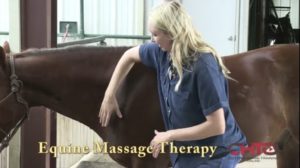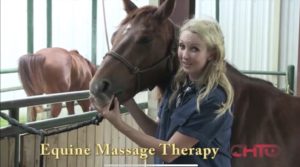
Tiffani Veltri assessing a horse
Like any athlete, a cutting horse must be kept comfortable in order to perform to the best of his ability. While this involves a team of people such as the vet, farrier, and equine dentist, another health modality that’s becoming increasingly popular is massage therapy. Nationally Certified Equine Massage Therapist Tiffanie Veltri said massage can have immediate benefits for helping a horse release tension and rehab sore muscles.
“One crucial area of massage therapy is making sure those muscles are functioning properly so they can control the joint properly,” Veltri said.
Veltri demonstrated how massage can relax a horse on an anxious four year old gelding. After applying gentle pressure, called palpating, to his neck muscles, in just a matter of minutes, the horse quickly let down, dropped his head, licked his lips and overall looked more at ease.
Chiropractors and therapists focus on the licking and chewing that horses do as signals that they are relaxed and released.
Massage also helps to improve locomotive skills.
“Horses that have sore muscles, tight muscles, or injuries or recovering from an injury, we can help improve those motor skills back to performance level and not injure themselves further or have to go into stall rest,” she said.
Another benefit to massage is improved circulation. Better blood flow aids injury repair while also helping reduce swelling in the body.
A lesser known benefit of massage is one that can have enormous impact on some horses: the ability to build trust. Veltri said if a horse is nervous or suffered some kind of trauma, massage can help build that connection with the horse to help both their mental and physical state.
Before treating a horse, Veltri wants to know the health history of the horse. This includes the horse’s diet, farrier work, dental work, and what the vet has been doing to maintain the horse.

Tiffani beginning a massage
Veltri stressed the importance of developing a team with the vet, farrier, chiropractor and massage therapist. She said they should all be on the same page to avoid redundancies or conflicting treatments.
For example, she said sometimes incorrect farrier work can cause strain on the muscles. A team that discusses their work can alleviate these issues quickly or prevent them altogether.
Veltri said she loves to work with chiropractors in particular because, “…a chiropractor will come in and adjust the horse’s joint. They are either luxated or sub-luxated, sub-luxation meaning the joint is no longer in its proper location. And what is causing that to happen is the muscle is actually pulling that joint out of the proper location. So
you have to address the release of the muscle so the tendons and ligaments and joint can go back to its proper location.”
Veltri said she likes to come in a few days before the chiropractor so she can get the muscles released so the chiropractor’s work can last longer.
Veltri said the key is to identify muscle soreness in your horse at home or at shows by looking at how they stand and move, and by feeling their muscles using the practice of palpating.
To palpate the horse, apply direct downward force with the soft part of your fingertips to check for soreness while watching to see if they have muscle spasms or move away from the pressure. A horse will give you a reaction because of their flight response.
When the horse is reactive in an area there are different techniques that Veltri uses. The first one is passive touch or mild pressure that she applies, until the horse relaxes. She said you will see their eyes soften. Warmth also helps soften and relax muscle.
After the horse drops his head and relaxes, she will move into a petrissage technique that uses a more pointed pressure on the muscles. Using her fingers, she works adhesions or knots in the muscles so the horse can relax that area of his body.
Veltri likes to start in the mouth. If you have mouth problems it can cause the horse to shake it’s head and be resistant in the bridle. A lot of issues can come from the muscles around the Temporomandibular joint in the jaw so she will check that point for a reaction.
She said each discipline creates common sore spots. Cutters use their front end to move, but they really have to engage their hind end. A lot of people don’t realize that a horse’s shoulders are not connected to the rest of the body by bone. The shoulder blade is attached by a muscle sling. So the shoulders can come up sore in cutters because of how hard they
use themselves.
She then moves to the thoracic, rib and abdominal muscles that get a lot of use just from the horse doing it’s job and carrying a rider and tack. The back is controlled by a big ring of muscles. If one of those muscles is not doing it’s job, the other muscles have to start doing more to compensate which can increase the risk of injuries.
Soreness can often vary on a horse from one side to the other. Veltri said sometimes the side the horse is compensating on can be injured instead of the side that is not functioning properly because of the extra strain.
Veltri’s goal is to get the muscles back to their functioning state by making sure the muscles aren’t tight or holding tension. If the issue has been going on a long time, the horse’s muscle memory must be retrained. She said this is when you have to bring the chiropractor and vet in to see if it’s due to training, or an anatomy and physiology issue.
As an owner, you can palpate the horse gently to find out how sore your horse is but Veltri cautions that “you make sure with your vet that you aren’t dealing with any health concerns or issues. That’s the biggest thing… just making sure everything has been cleared by the vet.”
She said it could be a very serious situation that could end up doing more harm than good. But gentle massage she said is a great way for owners to build that relationship with their horse and help maintain a healthy body.
Click here to watch Tiffani Veltri’s videos on how to palpate and massage your horse on CHTO